
Megachile rotundata, the alfalfa leafcutting bee, is a European bee that has been introduced to various regions around the world. As a solitary bee species, it does not build colonies or store honey, but is a very efficient pollinator of alfalfa, carrots, other vegetables, and some fruits. Because of this, farmers often use M. rotundata as a pollination aid by distributing M. rotundata prepupae around their crops. Each female constructs and provisions her own nest, which is built in old trees or log tunnels. Being a leafcutter bee, these nests are lined with cut leaves. These bees feed on pollen and nectar and display sexual dimorphism. This species has been known to bite and sting, but it poses no overall danger unless it is threatened or harmed, and its sting has been described as half as painful as a honey bee's.

Megachilidae is a cosmopolitan family of mostly solitary bees. Characteristic traits of this family are the restriction of their pollen-carrying structure to the ventral surface of the abdomen, and their typically elongated labrum. Megachilid genera are most commonly known as mason bees and leafcutter bees, reflecting the materials from which they build their nest cells ; a few collect plant or animal hairs and fibers, and are called carder bees, while others use plant resins in nest construction and are correspondingly called resin bees. All species feed on nectar and pollen, but a few are kleptoparasites, feeding on pollen collected by other megachilid bees. Parasitic species do not possess scopae. The motion of Megachilidae in the reproductive structures of flowers is energetic and swimming-like; this agitation releases large amounts of pollen.

Lotus corniculatus is a flowering plant in the pea family Fabaceae, native to grasslands in temperate Eurasia and North Africa. Common names include common bird's-foot trefoil, eggs and bacon, birdsfoot deervetch, and just bird's-foot trefoil, though the latter name is often also applied to other members of the genus.
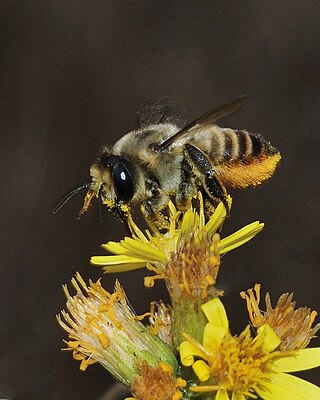
The genus Megachile is a cosmopolitan group of solitary bees, often called leafcutter bees or leafcutting bees; it also includes the called resin bees and mortar bees. While other genera within the family Megachilidae may chew leaves or petals into fragments to build their nests, certain species within Megachile neatly cut pieces of leaves or petals, hence their common name. This is one of the largest genera of bees, with more than 1500 species in over 50 subgenera. The alfalfa leafcutter bee is managed on a commercial scale for crop pollination, and has been introduced by humans to various regions around the world.
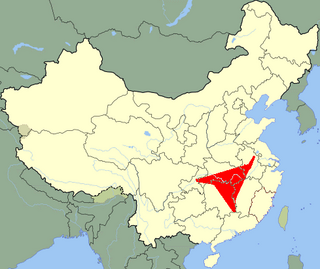
Pelophylax hubeiensis is a species of frog in the family Ranidae. It is endemic to China.
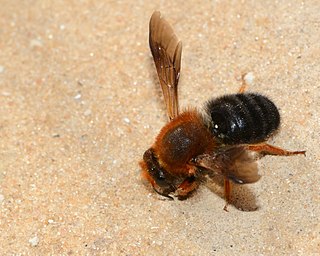
Chalicodoma is a subgenus of the bee genus Megachile in the family Megachilidae.

Jianghanichthys is an extinct genus of freshwater cypriniform fish from the Late Paleocene to Early Eocene of central and southern China, and the only member of the family Jianghanichthyidae. It is the oldest cypriniform fish known from body fossils, and the most basal known cypriniform.
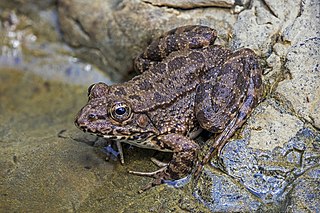
Pelophylax is a genus of true frogs widespread in Eurasia, with a few species ranging into northern Africa. This genus was erected by Leopold Fitzinger in 1843 to accommodate the green frogs of the Old World, which he considered distinct from the brown pond frogs of Carl Linnaeus' genus Rana.

Fraxinus hubeiensis is a species of ash native to Hubei province in China.

Megachile campanulae, known as the bellflower resin bee, is a species of bee in the family Megachilidae. Described in 1903, these solitary bees are native to eastern North America. Studies in 2013 placed them among the first insect species to use synthetic materials for making nests. They are considered mason bees, which is a common descriptor of bees in several families, including Megachilidae. Within the genus Megachile, frequently also referred to as leafcutter bees, M. campanulae is a member of the subgenus Chelostomoides, which do not construct nests from cut leaves, but rather from plant resins and other materials. Females lay eggs in nests constructed with individual cell compartments for each egg. Once hatched, the eggs progress through larval stages and subsequently will overwinter as pupae. The bees are susceptible to parasitism from several other bee species, which act as brood parasites. They are medium-sized bees and the female adults are typically larger than the males. They are important pollinators of numerous native plant species throughout their range.
Megachile angelarum is a species of bee in the Megachilidae family.
Chelostomoides is a subgenus of bees in genus Megachile. These bees do not cut leaves, but rather, use resin, mud, or other materials
Megachile cinnamomea is a species of bee in the family Megachilidae.

Megachile gentilis is a species of bee in the family Megachilidae. It was described by Cresson in 1872.
Megachile malangensis is a species of bee in the family Megachilidae. It was described by Friese in 1904.

Megachile mendica, the Flat-tailed Leafcutter Bee, is a species of solitary bee in the family Megachilidae. It was described by Ezra Townsend Cresson in 1878.
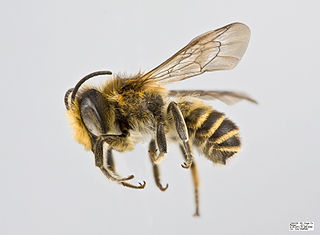
Megachile centuncularis, commonly known as the patchwork leafcutter bee, is a species of bee in the family Megachilidae. It was first described by the Swedish naturalist Carl Linnaeus in 1758.
Dichomitus hubeiensis is a crust fungus that was described as a new species in 2013. The fungus is characterized by the cream to straw-yellow pore surface and large pores numbering 1–2 per millimetre. Microscopic features include both inamyloid and indextrinoid skeletal hyphae, the presence of cystidioles and dendrohyphidia in the hymenium, and roughly ellipsoid spores that measure 10–14 by 5.6–7.0 μm. The specific epithet refers to the type locality in Hubei, central China.

Callomegachile is a subgenus of the bee genus Megachile in the family Megachilidae.













